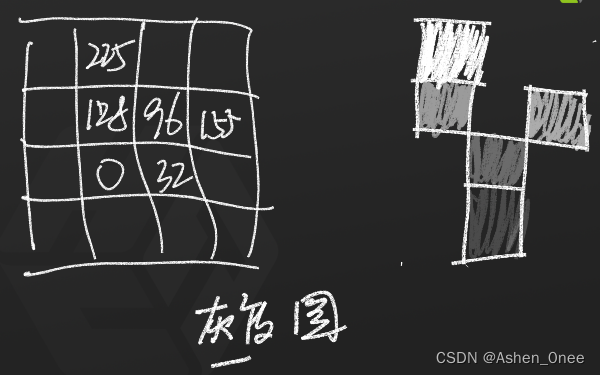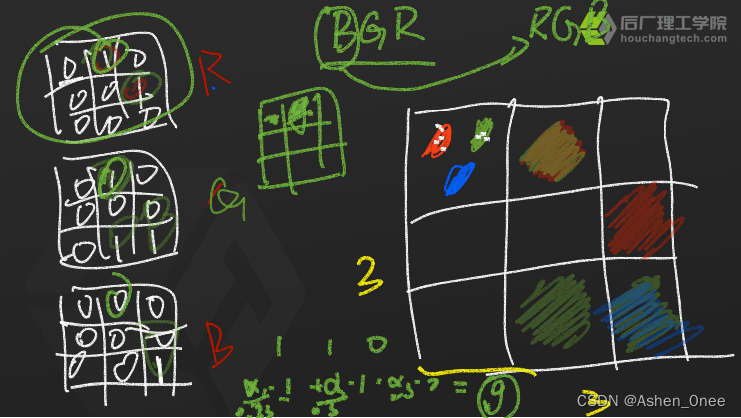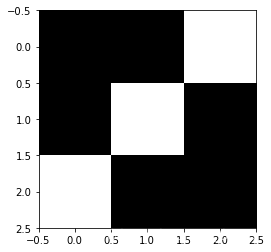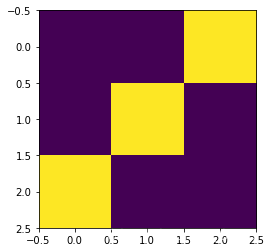-
9月14日计算机视觉基础学习笔记——基本图像处理
前言
本文为9月14日计算机视觉基础学习笔记——基本图像处理,分为四个章节:
- 计算机视觉的由来;
- 计算机如何看到图像;
- 计算机处理图像的方式、方法;
- 图像处理。
一、计算机视觉的由来
- 视觉能力: 会看、会展示,但不会处理、更不会思考、会玩。
- 数码照相机: 会看、会玩、会更多的处理;
- Auto-PS:
- 找到人脸位置——人脸检测;
- 定位五官——关键点检测;
- 磨皮:blur;瘦脸、大眼:仿射变换;口红、白牙:色彩变换。
二、计算机如何看到图像
- 感光器件;
- 显像管与显示屏;
二值图像:

灰度图:

RGB:

图像采集过程:

三、计算机处理图像的方式、方法
实际上是对矩阵的处理。
1、直接从 camera 读取
cap = cv.VideoCapture(0)- 1
2、从文件读取
img = cv.imread("lena.jpg") img_RGB = cv.cvtColor(img, cv.COLOR_BGR2RGB) print(img.shape) >>> (722, 726, 3) # Range of Interest roi = img_RGB[100:200, 300:400] plt.imshow(img_RGB) plt.imshow(roi)- 1
- 2
- 3
- 4
- 5
- 6
- 7
- 8
- 9
- 10
- 11


3、生成矩阵显示
import cv2 as cv import numpy as np import matplotlib.pyplot as plt img0 = np.array([[0, 0, 1], [0, 1, 0], [1, 0, 0]]) print(img0) print(img0.shape) print("img0 size = {}, {}".format(img0.shape[0], img0.shape[1])) >>> [[0 0 1] [0 1 0] [1 0 0]] >>> (3, 3) >>> img0 size = 3, 3 # 灰度图片 plt.imshow(img0, cmap="gray") # 彩色图片 plt.imshow(img0)- 1
- 2
- 3
- 4
- 5
- 6
- 7
- 8
- 9
- 10
- 11
- 12
- 13
- 14
- 15
- 16
- 17
- 18
- 19
- 20
- 21


四、图像处理
1、颜色空间转换
(1)、RGB to HSV
- H: 色调;
- S: 饱和度;
- V: 亮度。
img_hsv = cv.cvtColor(img, cv.COLOR_BGR2HSV) plt.imshow(img_hsv)- 1
- 2

# 肤色检测 # 二值化:非0即最大值。 img_gray = cv.cvtColor(img, cv.COLOR_BGR2GRAY) ret, thresh = cv.threshold(img_gray, 128, 200, cv.THRESH_BINARY) plt.imshow(thresh)- 1
- 2
- 3
- 4
- 5

2、图像的平移

- 平移的原理:
[
1
0
t
x
0
1
t
y
]
[
x
y
1
]
=
[
x
+
t
x
y
+
t
y
]
[ 1 0 t x 0 1 t y ] =[ x y 1 ] [1001txty]⎣ ⎡xy1⎦ ⎤=[x+txy+ty][ x + t x y + t y ]
3、图像的模糊与锐化
img_blur = cv.GaussianBlur(img_RGB, (11, 11), 1, 0) # 高斯模糊 plt.imshow(img_blur)- 1
- 2

4、加水印
wm = cv.imread("UoB.png") wm = cv.resize(wm, (300, 300)) wm = cv.cvtColor(wm, cv.COLOR_BGR2RGB) wm = wm - 255 img1 = cv.resize(img_RGB, (300, 300)) print(wm.shape) >>> (300, 300, 3) plt.imshow(cv.add(wm, img1)) plt.imshow(cv.addWeighted(wm, 0.9, img1, 0.5, 0))- 1
- 2
- 3
- 4
- 5
- 6
- 7
- 8
- 9
- 10

-
相关阅读:
原生安卓打包Vue 项目成apk安装包
【会议征稿,CPS出版】第四届管理科学和软件工程国际学术会议(ICMSSE 2024,7月19-21)
【程序人生】4年创作纪念日,不忘初心,继续前行
589. N 叉树的前序遍历——迭代法实现
少年,该升级 Vue3 了!
[笔记]RestController统一返回结果格式
设计模式-单一职责原则
第十四届蓝桥杯模拟赛(第二场)题解·2022年·C/C++
《痞子衡嵌入式半月刊》 第 103 期
抖音播映量破500的原因找到了,不是内容不好,而是这5个功能
- 原文地址:https://blog.csdn.net/Ashen_0nee/article/details/126846786
